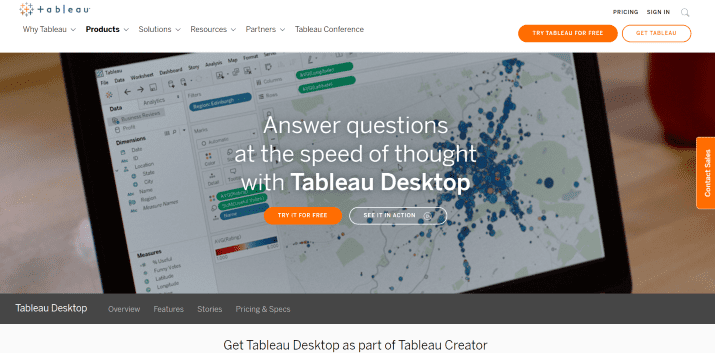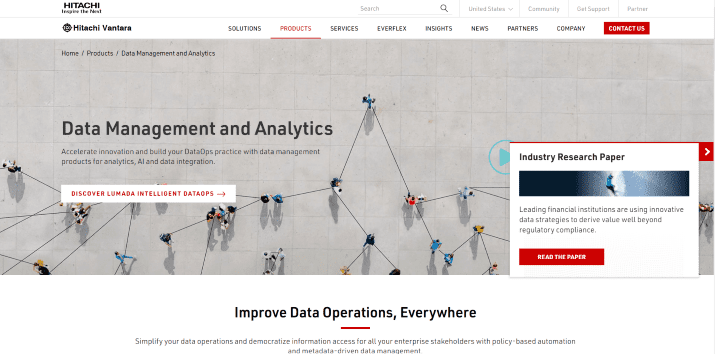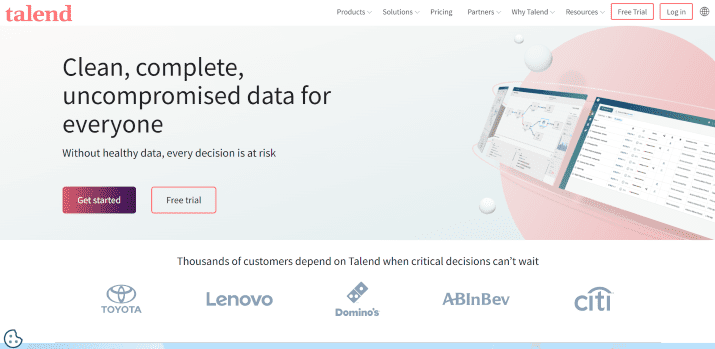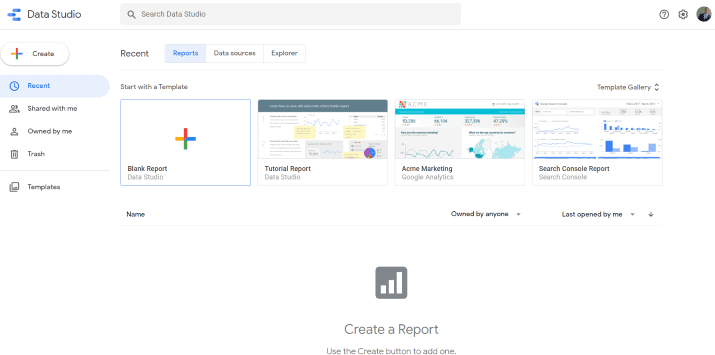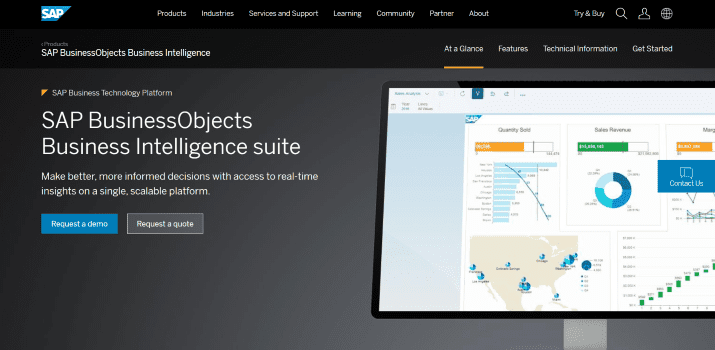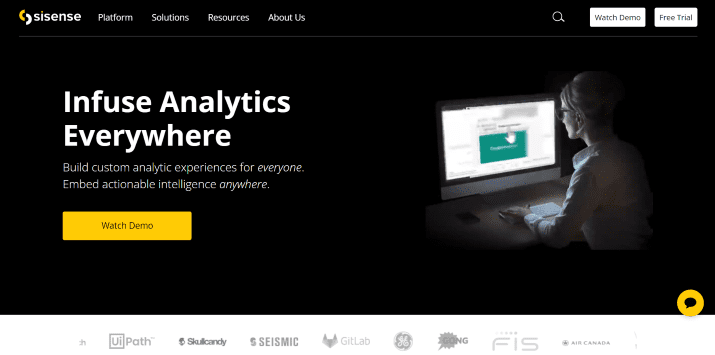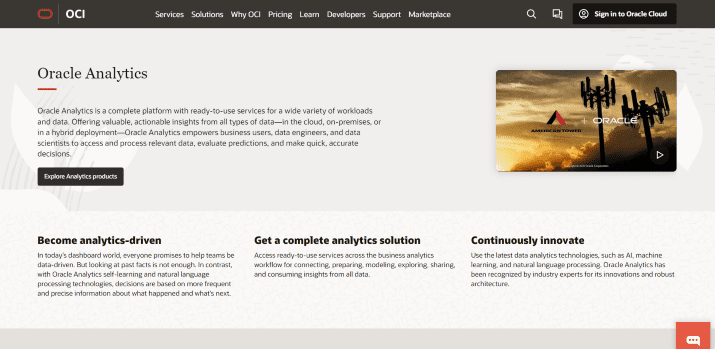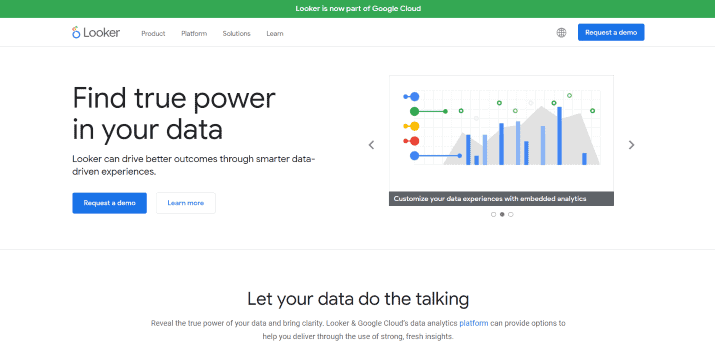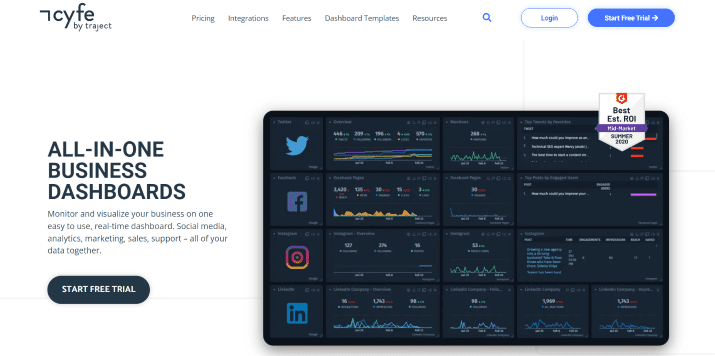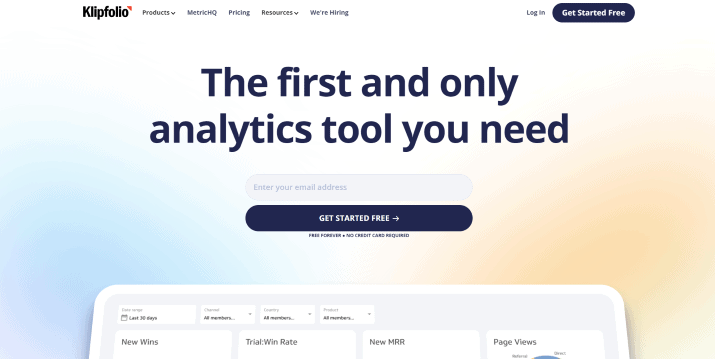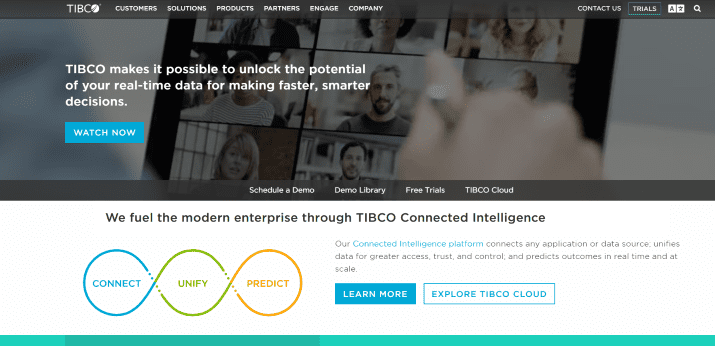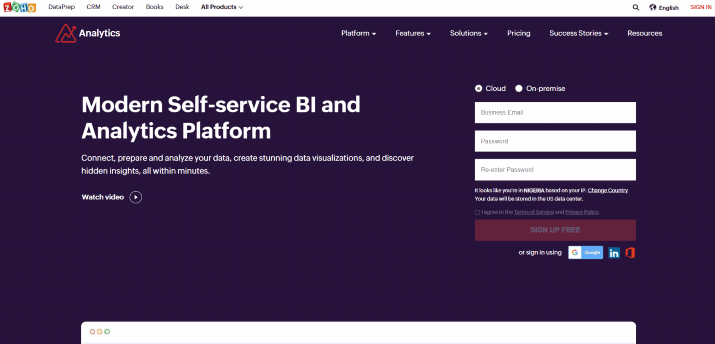In 2021, Gartner recognizes Microsoft as the leader in BI and analytics for the fourteenth year in a row. With Power BI, Microsoft is doubling down on its commitment to simplifying data access, authoring, and sharing across your organization.
Power BI is without a doubt one of the most popular BI tools on the market. It allows you to create dashboards and reports from data that is stored in Excel, SQL Server, or Azure.
However, despite its popularity, there are some limitations to Power BI. For example, it does not support Tableau Desktop files, and it has limited functionality when it comes to data modeling.
If you are looking for a BI tool that has more features and capabilities than Power BI, then you should consider using one of the Power BI alternatives listed in this article.
Also Read: Is Power BI Free?
Best Power BI Alternatives
1. Tableau Desktop
Tableau Desktop is a BI tool that is made by Tableau Software.
It allows you to create dashboards and reports from data that is stored in Excel, SQL Server, or Azure.
Tableau has been in the market for 15 years now, so it has an established customer base of over 100k customers including big brands like Apple Inc., eBay Inc., Salesforce.com Inc., Experian PLC, and more.
It is not free, but it does offer a free trial that you can use to see if it fits your needs before you buy it.
More than 13,000 new visualizations are shared each week, thereby making Tableau a very popular BI tool.
It offers great features like data visualization, dashboarding, and reporting.
You don’t need any technical knowledge about coding or anything like that because it has a drag-and-drop interface for creating charts and graphs from your spreadsheet data.
It also includes features like dashboards and reports that can be shared with others in real-time over the web or through email attachments.
Some of its useful features include:
Drag-and-drop interface for creating charts and graphs from your spreadsheet data
It has a drag-and-drop interface for creating charts and graphs from your spreadsheet data, so you don’t need any technical knowledge about coding or anything like that.
This makes it easy for anyone to use, regardless of their technical skills.
Visualizations that are updated in real-time
Tableau Desktop comes with a feature called “live connection” which allows you to connect to your data sources in real-time.
This means that your visualizations will be updated automatically as the data changes, so you don’t have to worry about refreshing them manually.
Great customer base and support
Tableau Desktop has been in the market for 15 years now, so it has an established customer base of over 100k customers including big brands like Apple Inc., eBay Inc., Salesforce.com Inc., Experian PLC, and more.
It also has a very good customer support system in place which includes forums, online training, and more.
While Power BI has a lot of similar features to Tableau, the latter has a couple of advantages.
For example, if you need to connect to multiple data sources or create reports that are updated in real-time then Tableau Desktop might be better suited for your needs.
This BI tool offers more customizable visualizations and dashboards than Power BI does as well.
Explore the best alternatives to Tableau.
2. Qlik Sense
Qlik Sense is another BI tool that can be used as an alternative to Power BI.
It was created by QlikTech, which is a company that was founded in 1993.
Qlik Sense comes with an All-in-one associative analytics solution for analyzing data and creating dashboards.
With Qlik Sense, you can use it to create visualizations and interactive dashboards that are based on your business requirements.
The tool also provides different types of apps, including a mobile app that you can use to access all the features available in the desktop version.
Qlik Sense is often compared with Power BI, and the two tools are quite similar.
However, there are a few differences between the two tools that you should be aware of before making your decision.
For example, Qlik Sense offers a better mobile experience than Power BI.
It also provides features like Associative Search that can help you find relevant data in seconds, and it allows you to view multiple sources of information at once.
If your business has a lot of data that needs analyzing regularly then using Qlik Sense might be more beneficial for your team.
Also Read: Qlik Sense vs Tableau
3. Pentaho
Pentaho by Hitachi is a business intelligence (BI) software company headquartered in Orlando, Florida.
It was founded in 2004 by Richard D’Amico and James Dixon. Pentaho provides an open-source platform for data integration, reporting, analysis, visualization, dashboard creation, and more.
The company now has over 15 million downloads of its software.
When it comes to an excellent Power BI alternative, Pentaho is one of the most effective choices.
The software focuses on providing you with a wonderful set of data visualization and reporting tools that are easy to use and master.
Its data integration capabilities make it a perfect choice for organizations dealing with a variety of data sources.
The main features of Pentaho include:
- Drag and drop functionality: With the drag and drop functionality, users are provided with a simple way to create reports. The user interface is also highly intuitive which makes it easy for newbies to get started.
- Data visualization tools – It has extensive data visualization tools that include charts, graphs, maps, tables, etc. These tools make it easy to understand complex data sets.
- ETL capabilities – Pentaho’s ETL (extract, transform, and load) capabilities see to it that the software can easily extract data from different sources, transform it, and load it into the desired destination.
- Community support – Pentaho has a large and active community of developers. This makes it easy to get help if you run into any problems while using the software.
Because it is an open-source tool, it can be used by anyone without any licensing fees.
The main benefit of using Pentaho over Power BI is that it can be deployed on-premise, as well as in the cloud.
This means that you don’t only need to depend on cloud services for data storage and processing.
4. Talend
Talend is a comprehensive platform for data integration and data integrity. It delivers the power, speed, and flexibility to tackle any integration challenges, including big data, cloud, streaming, or unstructured.
Its major features include:
- Design Studio for easy to use and integrate data.
- Open Source-based technology that provides a cost-effective solution for a broad range of integration needs, from simple ETL to complex real-time streaming or big data projects.
- Standardized application development techniques and proven practices so you can speed time-to-market and reduce risk.
- A thriving global user community that shares best practices, builds connectors and applications, and helps you get the most out of your Talend investment.
In comparison with Power BI, Talend has its strength in data integration and offers a lower total cost of ownership.
Also, Talend is an open-source platform that gives users more freedom and flexibility to customize the platform as per their needs.
5. Google Data Studio
Google Data Studio is a great tool for creating beautiful data-driven reports. It has a simple drag-and-drop interface and comes with built-in templates that you can use to get started quickly.
You can use it only to convert your data into reports, but also for summarizing it into dashboards.
The built-in charts and maps are easy to customize and if you need something more advanced, there’s an option to write SQL queries (or just use Google Analytics as a data source).
You can even integrate your own custom code using HTML tags or JavaScript libraries like jQuery.
It was made freely available in 2016, which means that anyone can use this software without having to pay any fees and this gives it some leverage over Power BI.
It’s still a beta version but has already been used by many companies around the world including Facebook and Twitter.
Also, like Power BI, it can be integrated with other Google products like Google Drive and AdWords. This will come in handy when you want to share your reports within your team or with clients.
Explore: Power BI Dashboard vs Report
6. SAP Business Intelligence
SAP Business Objects Business Intelligence (BI) is one of the top business intelligence software that was founded in 1992. It has made a name for itself by offering end-to-end BI solutions.
The tool helps users to make better and faster decisions by providing them with the insights they need.
The software offers users a suite of tools to help them analyze their data, including reporting, analysis, dashboarding, and visualization.
One of the advantages of using SAP BI is that it offers a wide range of features for users of all levels of experience. It also has a robust partner and support network that can help you get up and running quickly.
Unlike Power BI, it is the On-premise business intelligence software, so organizations need to install it on their servers.
SAP Business Objects BI does have a steep learning curve and might be a bit complicated for non-technical users. However, there are plenty of tutorials and guides to help users get started.
7. Sisense
Sisense is a BI tool that allows you to create dashboards and reports from data that is stored in Excel, SQL Server, or Azure.
The company was founded in 2004 and has since been named “Best Business Intelligence Software” by Gartner, and the most innovative software company in Israel.
Sisense offers AI-driven insights, which can be used to identify trends and correlations that would otherwise be missed.
It is used by over 2000 companies worldwide to unlock the full potential of their data and make better decisions.
Sisense can be used by any company regardless of its size or industry.
Its features include data preparation, reporting, visual analytics, smart alerts, and advanced analytics.
One of the key advantages of Sisense over Power BI is that it utilizes disk, RAM, and CPU resources more efficiently, meaning that it can handle larger data sets than Power BI.
8. Oracle Analytics Cloud
Oracle Analytics Cloud is a comprehensive cloud-based platform that enables you to perform sophisticated data analysis and reporting.
It offers a wide range of features, including self-service data preparation, interactive dashboards and visualizations, predictive analytics, and more.
With this solution, anyone can access and transform data, create collaboration stories for a better understanding of the details, and make informed decisions.
Furthermore, Oracle Analytics Cloud is highly scalable and allows you to access data from multiple sources.
Oracle Analytics Cloud Key Features:
- Data visualization – Delivers interactive charts and graphs to help you explore your dataset visually. Some types are even animated so you can see how they change over time.
- Drill down – It lets you deep-dive into data with interactive visuals, without having to export it first. Just click on a slice of your chart and explore the underlying data.
- Storytelling – Combines charts, text, and multimedia content to help you communicate your findings in a clear, concise way.
- Predictive analytics – Uses machine learning algorithms to identify patterns and trends in your data, so you can make predictions about the future.
Like Power BI, Oracle Analytics Cloud offers self-service data preparation, interactive dashboards and visualizations, and more.
However, it also includes features like predictive analytics and storytelling that are not available in Power BI.
Additionally, Oracle Analytics Cloud is highly scalable and can access data from multiple sources, while Power BI is limited to one source per dashboard.
9. Looker
Looker is a business intelligence (BI) and data visualization platform. It enables you to explore your data, create dashboards, and share insights with your team.
It offers various features such as:
- A user-friendly interface that makes it easy to explore your data and create dashboards
- The ability to share insights with your team members
- Integration with popular tools such as Salesforce, Google Sheets, and Tableau
The ability to customize Looker as per your requirements and build apps on top of it makes it a popular choice among businesses.
Looker is a better choice if you are looking for a user-friendly interface, the ability to share insights with your team members, and integration with popular tools.
It is also a good alternative to Power BI if you need features such as data analysis and modeling.
Also Read: Looker vs Tableau
10. MicroStrategy
MicroStrategy is one of the best business intelligence and analytics platforms in the market.
It offers a wide range of features for data analysis, reporting, visualization, and dashboarding. The platform is used by organizations of all sizes, from small businesses to large enterprises.
Its embedded analytics capabilities and comprehensive suite of tools make it a powerful option for data-driven decision-making.
MicroStrategy has some major clients, including Disney, Pfizer, Standard Chartered, and Genesys.
This is a testament to its capabilities as a trusted business intelligence platform.
In comparison with Power BI, MicroStrategy offers more for less.
It is a cheaper option and provides more features than Power BI at the same price point. For example, you get real-time data alerts on your phone with MicroStrategy, but you don’t with Power BI.
Also, both platforms are pretty similar in terms of functionality and ease of use. You can easily create dashboards and drill down into the data on both.
11. Cyfe
Cyfe is a cloud-based business intelligence platform that enables users to monitor their business performance across all departments in one place.
It was founded in 2010 and is headquartered in San Francisco, California.
One of the most unique features of Cyfe is its ability to allow users to connect to and monitor data from over 200 different sources, including social media platforms like Twitter and Facebook.
This sets it apart from Power BI in terms of data connectivity.
The tool supports up to 15 languages, including English, Spanish, French, and German, and offers embedded analytic charts and reports.
This makes it easier for businesses to share their data across different departments.
It also provides a white-labeling feature that enables users to rebrand the tool with their own names and logos.
12. Databox
If you want to use a single platform for analytics, then Databox is the perfect solution for you. It comes with tons of integrations and can work with almost any other data source.
Databox was one of the fastest-growing software companies in 2019 because of its unlimited possibilities.
It has since grown to include over 100 integrations, making it the perfect platform for data-driven businesses.
Databox helps businesses turn their raw data into actionable insights. It collects and connects all your business metrics from anywhere, giving you a single place to accelerate decisions at every level of your organization.
One of the biggest benefits of Databox is its ability to connect with almost any source of data. You can collect data from Google Sheets, Mixpanel, Salesforce, and more.
You can easily calculate metrics and ROI without worrying about the data.
Databox also offers a wide range of integrations with other popular software solutions like Tableau, Slack, and Mailchimp.
You can get started with Databox for free and upgrade to a paid plan when you need more features.
Databox offers better customer service than Power BI. They have a great team who are always ready to help you out and provide solutions for your problems.
13. Klipfolio
Klipfolio is considered one of the best Power BI alternatives that provide a powerful dashboard platform.
It is designed for business intelligence, analytics, and performance marketing teams to monitor key metrics across various devices.
Klipfolio is equipped with plenty of features such as data connectors, visualizations, alerting, and reporting tools that can help businesses in tracking their growth at all times.
It enables businesses to build dashboards for several use cases such as marketing, sales, and operations.
Klipfolio is a cost-effective solution that is designed for small and medium-sized businesses to help them in making better business decisions through data analytics.
This solution is used by popular brands such as Visa, KPMG, and IBM.
It has over 300 data sources and offers a wide range of integrations for major apps and services such as Google Analytics, Facebook ads, QuickBooks, Salesforce, Mailchimp, and more.
Klipfolio is easier to use than Power BI. It allows the user to set up dashboards in minutes and offers instant access to data.
14. TIBCO Software
TIBCO creates software for large organizations to use on-site or in the cloud
It offers companies the two-second advantage which is the ability to capture the right information on time and leverage on it to get ahead of the competition
TIBCO has more than 4000 customers worldwide who rely on its analytics to manage information and make decisions in real-time.
Like Power BI, TIBCO enables users to access data anywhere and anytime.
It offers a plethora of features like cloud-based solutions, advanced analytics, predictive analysis, mobile apps support, etc.
TIBCO is used in Amazon’s personalized recommendation engine for the Amazon website.
15. Zoho Analytics
Zoho Analytics is a comprehensive business intelligence and analytics platform. It offers all the features of Power BI.
It can be used to create reports, dashboards, data visualizations, and insights. It also offers features that are missing in Power BI.
These include machine learning and AI, predictive analysis, and the ability to embed reports and dashboards in webpages or applications.
Zoho connects to a wider number of data sources. It also allows you to collaborate with other team members on the same project. You can share reports with your colleagues or friends.
This tool is used by brands such as Johnson Controls and Suzuki.
Also Read: Bad Data Visualization Examples
Conclusion
Any organization looking for a comprehensive business intelligence (BI) and data visualization tool should consider Power BI. It is an extremely powerful platform with a wide range of features.
However, if you’re not happy with Power BI or find that it doesn’t fit your needs, there are plenty of other great BI software out there. Many of the best Power BI alternatives above are also available in free or trial versions so you can try them before committing to a purchase.
Our top pick is Tableau, which is not only a great BI tool but also has excellent customer support.
Whatever your needs, there’s sure to be a BI tool that’s perfect for you. So don’t wait – start exploring your options today.
Tom loves to write on technology, e-commerce & internet marketing.
Tom has been a full-time internet marketer for two decades now, earning millions of dollars while living life on his own terms. Along the way, he’s also coached thousands of other people to success.
